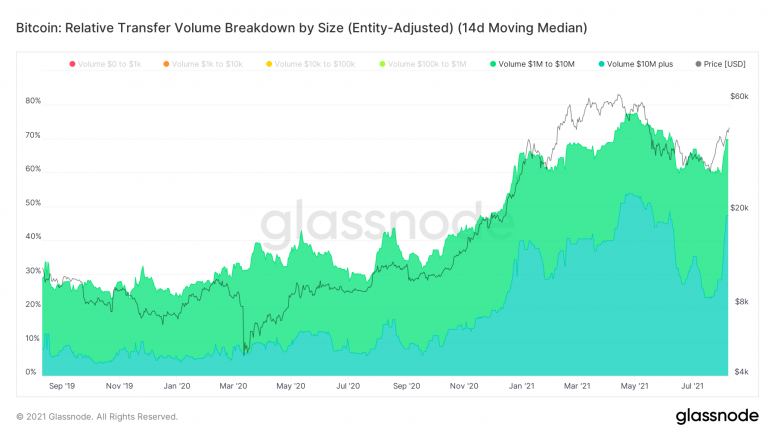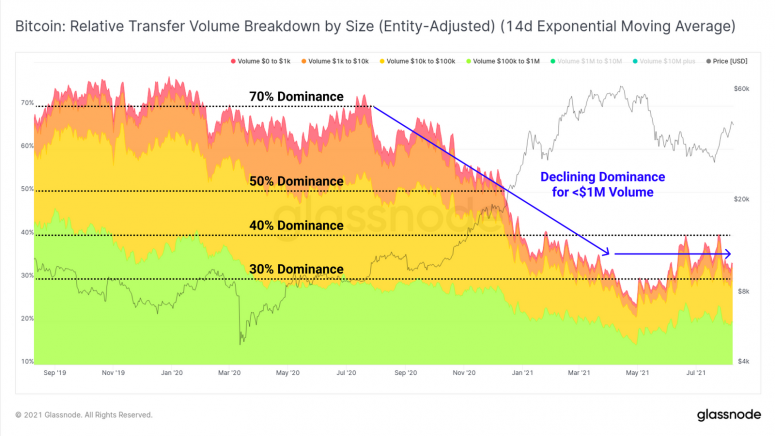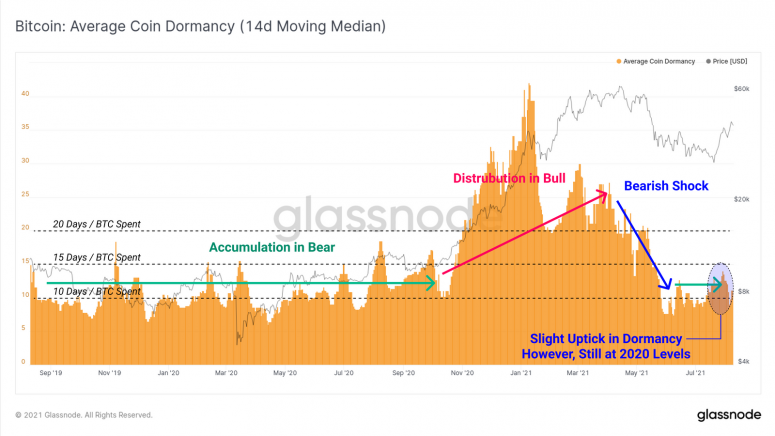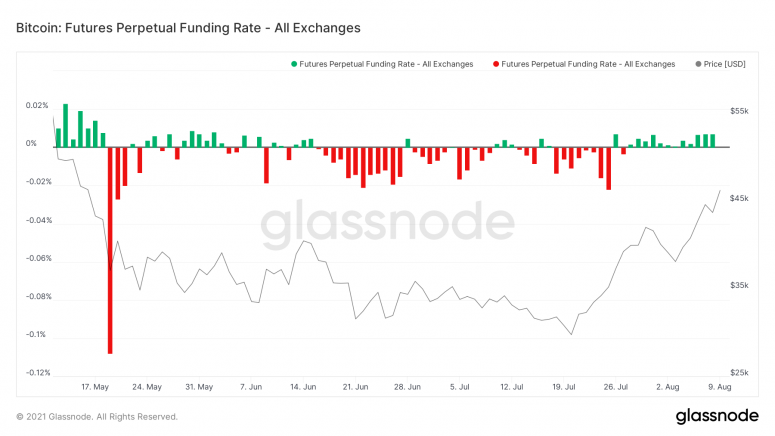Lawmakers and regulators’ increasing scrutiny of crypto markets, including the debate over the U.S. infrastructure bill’s crypto tax reporting provision, may be spooking retail investors but not institutional ones, recent blockchain data from Glassnode indicates.
These larger investors, as represented by large-value dollar transactions, fueled Bitcoin’s nearly 20% price gains since last week, the Berlin-based blockchain data firm found. A number of analysts say the trend shows that these organizations are focusing more on the cryptocurrency’s upside than potential obstacles.
“Investors are looking to the positives around regulation rather than the negative,” said Joel Kruger, cryptocurrency strategist at institutional crypto exchange LMAX Digital, noting “the fact that the U.S. government is listening and is aware that there is a provision around crypto in the infrastructure bill that needs more clarification.”
Bitcoin’s on-chain transaction volume with values of at least $1 million has risen 10% since the beginning of August, and accounts for nearly 70% of the total value transferred.

Meanwhile, small-size transactions have declined as a percentage of the overall market, as shown by the chart below. Transactions valued less than $1 million have dropped to around 30-40% of market dominance from 70% since July 2020.

Institutional investors’ recent bullishness comes as the crypto market monitors intense political and regulatory developments worldwide, including a hotly debated $28 billion tax reporting provision to the $1 trillion infrastructure bill in the U.S. and an ongoing crackdown in Europe and other regions against Binance, the world’s biggest crypto exchange by trading volume.
Despite the potential for greater regulatory oversight, institutional investors are optimistic about bitcoin’s future, analysts and industry experts say.
“In general, institutions would welcome regulation that is clear and fair,” said Andrew Tu, an executive at quantitative trading firm Efficient Frontier. “The recent price increase over the last week…has shown that the market does not react strongly to concerns over regulation, as opposed to actual legislation passing.”
In the latest infrastructure bill development on Monday, U.S. Sen. Richard Shelby (R-Ala.) filed an objection to a compromise amendment to the crypto tax reporting provision. The amendment would have exempted crypto transaction validators from a broadened definition of “broker.”
Kruger said that increased regulation helps validate the industry.
“This means the industry is getting recognized and this ultimately helps with acceptance and adoption,” Kruger said.
Others also said that the crypto market has become more used to news coming from regulators, as the industry matures.
“The crypto market is very used to regulatory concerns, especially the crypto OG hodlers (long-time holders) who have seen multiple cycles of regulatory uncertainty,” Tu said.
Indeed, on a 14-day median basis, the average number of days each BTC transacted remained dormant or unmoved, has risen slightly to around 10 days from seven days, according to Glassnode, meaning that some bitcoin “old hands are not taking exit liquidity at this stage.”

Market fundamentals turn stronger, healthier
Instead of focusing on regulatory uncertainties, institutional investors have highlighted bitcoin’s strengthening market fundamentals as a justification for their optimism.
“The regulatory concerns don’t impact bitcoin here as much as other cryptocurrencies, and the sentiment behind bitcoin has been showing signs of turning for a couple of weeks now,” said Noelle Acheson, head of Market Insights at Genesis. (Genesis is owned by CoinDesk parent company Digital Currency Group.)
On the supply side, bitcoin’s illiquid supply, or the balance held by illiquid entities, reached a record high recently, meaning that the oldest cryptocurrency has a weakness in supply.
The perpetual derivatives market’s funding rates have turned positive again after they went negative for most of June and July.

Calculated every eight hours, the funding rate refers to the cost of holding long/short positions in the bitcoin perpetuals (futures with no expiry) market. The metric is used by exchanges offering perpetuals to balance the market and guide perpetual prices toward the spot price.
A positive funding rate means longs are paying shorts to keep the position open, and the market is skewed bullish. Meanwhile, a negative funding rate implies a bearish market positioning.
As CoinDesk reported, bitcoin’s put-call open position ratio also recently dropped to the lowest level this year on increased activity in calls, or bullish bets.

At press time, bitcoin was changing hands at $46,201.20, up by 5.32% in the past 24 hours, according to CoinDesk 20.
 coindesk.com
coindesk.com